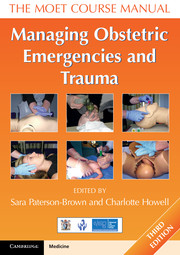Book contents
- Frontmatter
- Dedication
- Contents
- Working Group
- About the authors
- Acknowledgements
- Abbreviations
- Section 1 Introduction
- Section 2 Recognition
- Section 3 Resuscitation
- Section 4 Trauma
- Section 5 Other medical and surgical emergencies
- Section 6 Obstetric emergencies
- 24 Pre-eclampsia and eclampsia
- 25 Major obstetric haemorrhage
- 26 Caesarean section
- 27 Placenta accreta and retained placenta
- 28 Uterine inversion
- 29 Ruptured uterus
- 30 Ventouse and forceps delivery
- 31 Shoulder dystocia
- 32 Umbilical cord prolapse
- 33 Face presentation
- 34 Breech delivery and external cephalic version
- 35 Twin pregnancy
- 36 Complex perineal and anal sphincter trauma
- 37 Symphysiotomy and destructive procedures
- 38 Anaesthetic complications in obstetrics
- Section 7 Triage and transfer
- Section 8 Human issues
- Index
35 - Twin pregnancy
- Frontmatter
- Dedication
- Contents
- Working Group
- About the authors
- Acknowledgements
- Abbreviations
- Section 1 Introduction
- Section 2 Recognition
- Section 3 Resuscitation
- Section 4 Trauma
- Section 5 Other medical and surgical emergencies
- Section 6 Obstetric emergencies
- 24 Pre-eclampsia and eclampsia
- 25 Major obstetric haemorrhage
- 26 Caesarean section
- 27 Placenta accreta and retained placenta
- 28 Uterine inversion
- 29 Ruptured uterus
- 30 Ventouse and forceps delivery
- 31 Shoulder dystocia
- 32 Umbilical cord prolapse
- 33 Face presentation
- 34 Breech delivery and external cephalic version
- 35 Twin pregnancy
- 36 Complex perineal and anal sphincter trauma
- 37 Symphysiotomy and destructive procedures
- 38 Anaesthetic complications in obstetrics
- Section 7 Triage and transfer
- Section 8 Human issues
- Index
Summary
Objectives
On successfully completing this topic, you will be able to:
understand how to assess suitability for vaginal delivery
understand how to safely manage appropriate vaginal twin deliveries.
Introduction
Dizygous twinning rates vary enormously depending on age, parity, racial background and assisted-conception techniques. The incidence of twin pregnancies continues to increase, largely due to assisted reproduction techniques, giving a multiple birth rate of 16/1000 maternities in England and Wales in 2009. Monozygous twinning rates are relatively constant, with an incidence of 3.5/1000 births. Overall maternal and perinatal mortality and morbidity are higher in multiple gestations than in singletons. Premature delivery and the complications of prematurity are the main contributors to adverse outcomes. Other factors contributing to the risk are: intrauterine growth restriction; congenital anomalies; malpresentation; cord prolapse; and premature separation of the placenta.
The use of routine antenatal ultrasound assessment has facilitated the diagnosis of multiple gestations. Women with multiple fetuses who attend for antenatal care should have the chorionicity of the pregnancy determined early in pregnancy and then have serial growth scans as specified in the recent NICE and RCOG Greentop guidelines on the antenatal care of multi ple pregnancies. It is recommended that monochorionic twins are delivered after 36+0 weeks following a course of antenatal steroids, and dichorionic twins are delivered after 37+0 weeks.
- Type
- Chapter
- Information
- Managing Obstetric Emergencies and TraumaThe MOET Course Manual, pp. 411 - 416Publisher: Cambridge University PressPrint publication year: 2014

